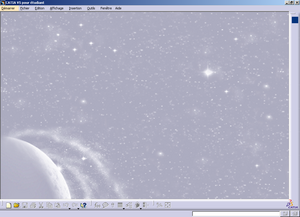KWWidgets/Projects/3DWidgets/Part2/Study/Construction: Difference between revisions
No edit summary |
No edit summary |
||
| Line 58: | Line 58: | ||
| valign="top"| | | valign="top"| | ||
|- | |- | ||
| Line 71: | Line 63: | ||
''' Reference Elements ''' | ''' Reference Elements ''' | ||
| valign="top"| | | valign="top"| | ||
Create points, lines and planes. | |||
| valign="top"| | | valign="top"| | ||
| Line 78: | Line 70: | ||
''' Boolean Operators ''' | ''' Boolean Operators ''' | ||
| valign="top"| | | valign="top"| | ||
Tools for assembling, adding, removing, intersecting, and trimming bodies, also for keeping and removing object faces. | |||
| valign="top"| | | valign="top"| | ||
Revision as of 08:10, 31 October 2006
CATIA v5
CATIA v5 is produced by IBM: [1]
- CATIA V5 is the leading product development solution for all manufacturing organizations, from OEMs through their supply chains to small independent producers. The range of its capabilities allows CATIA V5 to be applied in a wide variety of industries, such as aerospace, automotive, industrial machinery, electrical, electronics, shipbuilding, plant design, and consumer goods, including design for such diverse products as jewelry and clothing.
- CATIA V5 is the only solution capable of addressing the complete product development process, from product concept specifications through product-in-service, in a fully integrated and associative manner. It facilitates true collaborative engineering across the multi-disciplinary extended enterprise, including style and form design, mechanical design and equipment and systems engineering, managing digital mock-up, machining, analysis, and simulation. Extract from IBM website linked above
Widgets
|
Measuring Angles |
CATIA's angle measurement widget two lines, a line and a curve, two curves, a curve and a surface, a line and a surface, a line and a plane, or two surfaces. It even permits the measurement of the complimentary angle between two curves. |
|
|
Measuring Distances |
Distances can be measured between points, lines, curves, surfaces, planes, edges and arc centres. The tool also permits the measurement of minimum and maximum distances, to chain together a series of measurements or a fan of measurements. |
|
|
Different possible measurements include: distance, angle, complimentary angle, radius, diameter, centre point, centre of gravity, perimeter and area. |
||
|
Manipulators |
||
|
Rotation |
||
|
Dimension Manipulators |
||
|
Reference Elements |
Create points, lines and planes. |
|
|
Boolean Operators |
Tools for assembling, adding, removing, intersecting, and trimming bodies, also for keeping and removing object faces. |
|
|
Transformation Features |
Permits transformations of an object such as rotations, symmetry, mirror, patterns and scales. |
|
|
Draft Analysis |
Performs an analysis of a draft angle on an object to see whether the piece may be easily removed. |
|
|
Structural Analysis |
Performs first-order structural analyses:
|
|



